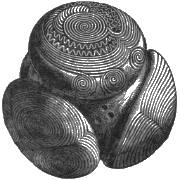Canmore Site 712: WHITE NESS, ST OLA'S CHURCH - TINGWALL - CHURCH (MEDIEVAL), CROSS(S) (EARLY MEDIEVAL), INHUMATION (VIKING), OGHAM INSCRIBED STONE (EARLY MEDIEVAL)
Description
| Site Name | WHITE NESS, ST OLA'S CHURCH |
|---|---|
| Other Name(s) | WHITENESS |
| Site Number | HU34SE 3 |
| Broad Class | MONUMENT (BY FORM), RELIGIOUS RITUAL AND FUNERARY, COMMEMORATIVE |
| Site Type(s) | CHURCH (MEDIEVAL), CROSS(S) (EARLY MEDIEVAL), INHUMATION (VIKING), OGHAM INSCRIBED STONE (EARLY MEDIEVAL) |
| NGR | HU 3866 4442 |
| Local Authority | SHETLAND ISLANDS |
| Parish | TINGWALL |
| Record created | 1988-02-08 |
| Last updated | 2007-05-31 |
Archaeology Notes
HU34SE 3 3866 4442
(HU 3867 4443) St Ola's Church (LB) (Site of)
OS 6" map, Shetland, 2nd ed. (1903)
A low platform in the north side of the graveyard, which is still in use, is probably the site of the chapel.
(MS. notes by A MacDonald, Ministry of Public Buildings and Works, 29 September 1967)
A fragment of a grey sandstone cross-shaft with inter-lacing was found in the churchyard in 1933 and is now in the National Museum of Antiquities of Scotland (NMAS, Accession no. IB 248).
Proc Soc Antiq Scot 1937
In 1938 an iron axe-head, of late 9th century Viking type, was found with bones in a stone-lined grave. The axe is in the Town Hall collection, Lerwick.
RCAHMS 1946; H Shetelig 1954
There is no trace of the church at the OS site. The 'low platform', referred to by MacDonald,is the foundations of a building shown on the OS 6" 1903,and now demolished. The axe is in the Lerwick Museum (accession no: ARC 65381).
Visited by OS (RL) 3 May 1968
A fragment of red sandstone, sculptured on one side and bearing four or five oghams, (acc no: - ) and a fragment of grey sandstone having a meander pattern sculptured on one side (acc no: IB 256-7) were presented to the NMAS in 1946-7 by Peter Moar. They were dug up originally in the churchyard at Whiteness.
Proc Soc Antiq Scot 1949
NMAS IB 257 - found by Mr J H Goodlad in 1939 when digging a drain past the crofthouse on the croft known as Kirk-house, some 100 yards from the churchyard. He got the impression that the stone could have been re-used in a previous drain. Mr Moar acquired the stone from Mr Goodlad (information from Mr Goodlad personally, 1975).
(J Close-Brooks, NMAS, 16 October 1975)
A D S MacDonald and L R Laing 1969.
Identifiers and Links to Other Records
This record has no links! Would you like to help?
| Identifier / External Link | Linked Record | Status | Comment |
|---|---|---|---|
| Canmore Site Number (legacy): HU34SE 3 | No linked record | ||
| Canmore SMR Reference: SAT0941 | No linked record |
This area is visible only to logged in users.
